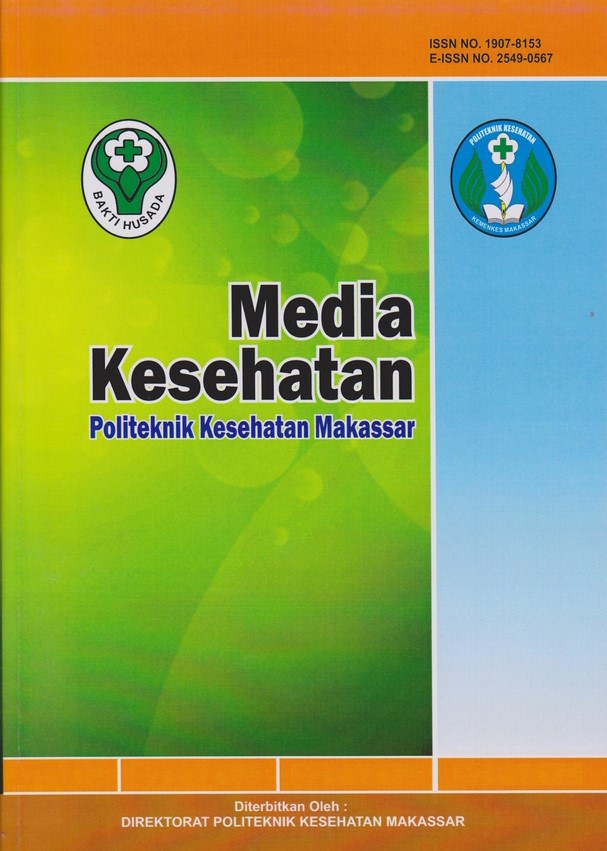Implementation of the Five Pillars of STBM on the Incidence of Stunting
DOI:
https://doi.org/10.32382/medkes.v19i2.1086Keywords:
5 Pilar, Sanitasi Total Berbasis Masyarakat (STBM), StuntingAbstract
Stunting cases in Maros Regency decreased from 3812 cases or 13.04% in 2020 to 2892 cases or 9.47%, but in 2022 the opposite happened, namely a significant increase in the number of cases and the prevalence of cases increased to 3750 cases or 12 .82%. In Tompobulu District, stunting cases have decreased from 12.69% in 2020, down to 12.11% in 2021. And in 2022 it will fall to 9.69%. Therefore, in this research we will analyze the relationship between the five STBM pillars and stunting cases in Tompobulu District, Maros Regency. The type of research in this research is research using a survey with a Cross Sectional Study approach. The population in this study were all stunted toddlers who were examined, totaling 146 toddlers. The sample in this research is the entire population. The results of the research show that there is a relationship between CTPS (0.005), drinking water and food management (0.005), securing RT waste (0.000), and securing liquid waste (0.000) with the incidence of stunting. Meanwhile, stopping defecation has no relationship with the incidence of stunting (0.911). The conclusion of this study is that the 4 variables in the study have a relationship with the occurrence of stunting. It is recommended that local communities increase awareness of the importance of sanitation in their area in order to reduce the high stunting rate.
Keywords: 5 Pillars, Community Based Total Sanitation (STBM), Stunting
References
Erna Kusumawati, Setyowati R, Hesti Permata S “Model Pengendalian Fektor Resiko Stunting pada Anak Usia dibawah 3 Tahun”. Vol 9. No.3 (online) https//media neliti.com/media/public ation/39896-Idmodel- pengendalian–faktor–resikostunting –pada-anak-bawah-tiga tahun.pdf. dinkes 2020.
Maharrani Anindhita, (2019), ”Angka Kematian Bayi di Indonesia” Diakses pada 04 November 2014.
Kementerian Kesehatan RI 2018”Hasil Utama RisKesDas” (online).https//hasil-riskesdas 2018.pdf.Dinkes 4 Januari 2020.
Kementrian Kesehatan RI 2014. “Permenkes Nomor 3 Tahun 2014 tentang Sanitasi Total Berbasis Masyarakat”. (online). https//peraturan.bpk.go.id/ Home/Details/116706/permenkes-no-3-tahun-2014
Torlesse, H., Cronin, A.A., Sebayang, S.K., Nandy, R., (2016). “Determinants of Stunting in Indonesia Children: Evidence from A-Cross_Sectional Survey Indicate a Prominent Role for the Water, Sanitation and Hygiene Sector in Stunting Reduction. BMC Public Health, 16:669. Page 1-11
Alfadhila Khairil S, Lailatul Muniroh, “Hubungan Faktor Water, Sanitation and Hygiene (WASH) dengan Stunting di wilayah kerja puskesmas kutokulong, Kabupaten Bondowoso”. Doi: 10.2473/amnt. V3i3.2019.164-170. (online).https://ejournal.unair.acid/AMNT/article /vie w/1353 Diakses 5 Januari 2022.
Schmidt dan Charles, W. 2014. Beyond Malnutrition: The Role of Sanitation in Stunted Growth Environmental Health Perspectives 122 (11):A298
Sutarto, Dian, M. and Indriyani, R. (2018). Stunting, Faktor Resiko dan Pencegahannya. Fossil Behavior Compendium. 5. pp. 243–243. doi: 10.1201/9781439810590-c34.
Kwami, C. S. et al. (2019). Water, sanitation, and hygiene: Linkages with stunting in rural Ethiopia. International Journal of Environmental Research and Public Health. 16(20). doi: 10.3390/ijerph16203793.
Sinatrya, A. K. and Muniroh, L. (2019). Hubungan Faktor Waterm Sanitation, and Hygiene ( WASH ) dengan Stunting di Wilayah Kerja Puskesmas Kotakulon , Kabupaten Bondowoso The Assosiation of Water , Sanitation , and Hygiene ( WASH ) factor with Stunting in Working Area of Puskesmas Kotakulon
Fadzila, D. N. and Tertiyus EP. Ketahanan Pangan Rumah Tangga Anak Stunting Usia 6-23 Bulan di Wilangan, Kabupaten Nganjuk Household Food Security of Stunted Children Aged 6-23 Months in Wilangan. Nganjuk District. 2019;(152):18–23.Risnawaty, G. (2017). Faktor Determinan Perilaku Cuci Tangan Pakai Sabun (CTPS) Pada Masyarakat Di Tanah Kalikedinding. Jurnal PROMKES. 4(1). p. 70. doi: 10.20473/jpk.v4.i1.2016.70-81
Downloads
Published
How to Cite
Issue
Section
PDF (Bahasa Indonesia) downloaded: 313















